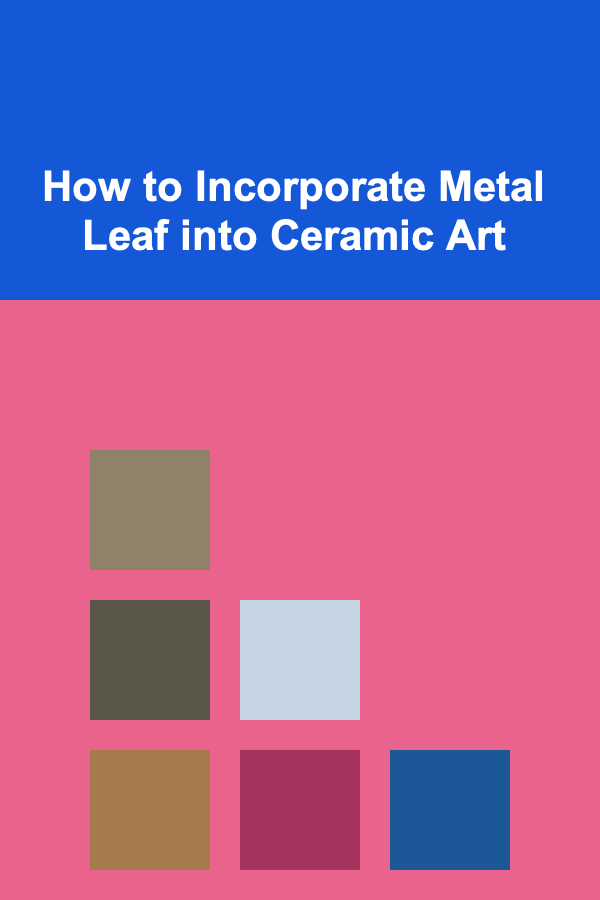
How to Incorporate Metal Leaf into Ceramic Art
ebook include PDF & Audio bundle (Micro Guide)
$12.99$10.99
Limited Time Offer! Order within the next:

Ceramic art has long been celebrated for its versatility and tactile beauty, offering artists the ability to create pieces ranging from functional pottery to intricate sculptures. One particularly striking technique that has gained popularity in the world of ceramics is the incorporation of metal leaf into ceramic works. Metal leaf, such as gold, silver, copper, or bronze, can be used to add visual depth, texture, and a sense of luxury to ceramic art pieces. This article will delve deeply into the methods, tools, and techniques involved in incorporating metal leaf into ceramic art, as well as explore the aesthetic and conceptual significance of this fusion of materials.
What is Metal Leaf?
Metal leaf is a thin, delicate sheet of metal that is hammered into extremely fine layers. It is typically available in various metals, including gold, silver, copper, and even aluminum. The sheets of metal leaf are incredibly thin---often measured in microns---making them perfect for applications that require a light touch or subtle metallic accents. Because of its fragility and reflective properties, metal leaf can add an unexpected but striking dimension to ceramic works.
There are various types of metal leaf available, including genuine metal leaf (made from the pure metal itself) and imitation metal leaf (which is made from base metals or alloys that mimic the appearance of the real thing). The former tends to be more expensive but offers a richer, more authentic metallic finish, while the latter can offer similar visual effects at a lower cost.
Why Incorporate Metal Leaf into Ceramic Art?
Incorporating metal leaf into ceramic art is not only about adding a decorative element; it can also enhance the conceptual impact of a piece. The inclusion of metal leaf offers both visual and material contrast to the often earthy and textured surfaces of ceramics. Here are several reasons why artists choose to use metal leaf in their ceramic creations:
- Aesthetic Enhancement: Metal leaf adds a brilliant, reflective quality to ceramics that enhances their visual appeal. Its radiant finish can create a luxurious and sophisticated look, especially when contrasted with matte glazes or raw clay surfaces.
- Symbolic Significance: Metal has symbolic and historical connotations. Gold, for instance, has long been associated with wealth, divinity, and enlightenment. By using metal leaf, artists can imbue their ceramics with deeper layers of meaning and create works that invite reflection on themes such as fragility, impermanence, and the transient nature of beauty.
- Textural Contrast: The addition of metal leaf can introduce a fascinating textural contrast to ceramic pieces. While ceramics can range from rough and tactile to smooth and glossy, the thinness and smoothness of metal leaf create an intriguing juxtaposition.
- Highlighting Form and Detail: Metal leaf is often used to highlight specific areas of a ceramic piece. Whether it's an intricate pattern, a raised design, or a particular section of a sculpture, the metallic sheen draws attention to these areas, enhancing the visual impact of the form.
- Innovative Artistic Expression: The fusion of ceramics and metal leaf allows artists to push the boundaries of traditional ceramic techniques and engage with new, contemporary approaches to pottery and sculpture. This innovation can result in pieces that are visually compelling and intellectually stimulating.
Materials Needed for Incorporating Metal Leaf into Ceramic Art
Before beginning the process of applying metal leaf to ceramics, it is important to gather the necessary materials and tools. Here's a list of the most essential items:
1. Ceramic Piece
- This can be any ceramic object that you plan to decorate with metal leaf. It could be a vase, bowl, sculpture, or tile. Ensure that the surface is smooth, clean, and ready to accept the metal leaf.
2. Metal Leaf Sheets
- Choose the metal leaf that suits your artistic vision. Gold, silver, copper, and other varieties are available. Each type of metal leaf has its unique reflective quality and color tone. Make sure to purchase metal leaf from a reputable supplier to ensure quality and durability.
3. Size or Adhesive
- Size is the adhesive used to adhere metal leaf to ceramic surfaces. The size is a gel-like substance that remains tacky after application, allowing metal leaf to adhere to it. It comes in various forms, such as oil-based, water-based, or acrylic, and needs to be applied thinly and evenly.
4. Brushes
- Soft, natural-bristled brushes are best for applying both the size (adhesive) and for handling the metal leaf. A brush with soft bristles helps to avoid damaging the delicate metal leaf and ensures even coverage of the adhesive.
5. Metal Leaf Sealer
- Once the metal leaf is applied, it is important to seal it to prevent tarnishing or flaking. A specialized metal leaf sealer helps protect the finish and gives the metal leaf a shiny, polished look. There are also matte sealers available for artists who prefer a less glossy finish.
6. Burnishing Tools
- Burnishing tools are used to gently press the metal leaf into the surface of the ceramic, ensuring it adheres firmly and smoothing out any wrinkles or imperfections. These tools can be made of various materials, such as bone or wood.
7. Protective Gloves
- Because metal leaf is so delicate and can easily be damaged by oils and dirt from your fingers, it's a good idea to wear protective gloves when handling the metal leaf.
8. Tweezers
- Metal leaf sheets are extremely thin and fragile, so tweezers are essential for handling them. Using tweezers helps prevent direct contact with the leaf and allows for precision when placing it onto the ceramic surface.
Techniques for Applying Metal Leaf to Ceramic Art
Once you have gathered your materials, it's time to start applying the metal leaf to your ceramic piece. There are several different techniques for incorporating metal leaf into ceramics, depending on the desired effect and style.
1. Traditional Application Method
The traditional method of applying metal leaf to ceramic involves several careful steps:
- Clean the Ceramic Surface: Begin by ensuring that the ceramic piece is completely clean. Remove any dust, dirt, or oils from the surface using a soft cloth. A clean surface is crucial for achieving an even application of metal leaf.
- Apply Size (Adhesive): Using a soft brush, apply a thin, even layer of size to the areas of the ceramic where you want the metal leaf to adhere. You can apply the size to specific patterns, textures, or the entire surface, depending on your design. Allow the size to become tacky (this usually takes around 15--30 minutes).
- Apply Metal Leaf: Once the adhesive is tacky, use tweezers to carefully lift the metal leaf sheet and place it onto the sticky areas of the ceramic. Gently press the leaf into place using a soft brush or burnishing tool. Avoid pressing too hard, as the leaf is very fragile.
- Remove Excess Metal Leaf: After applying the metal leaf, use a soft brush to gently sweep away any excess leaf from the surface. The metal leaf should only remain in the areas where the size was applied.
- Burnish the Surface: To smooth the metal leaf into the ceramic surface, use a burnishing tool or your fingers (with a cloth) to gently press the leaf down. This will help it adhere more securely to the ceramic and give it a smooth, polished finish.
- Seal the Metal Leaf: Once the metal leaf is applied and burnished, apply a sealer to protect the surface. The sealer will prevent the metal leaf from tarnishing and ensure its durability. Choose a sealer based on your desired finish (glossy or matte).
2. Water-based Metal Leaf Application
For a more flexible, subtle approach to incorporating metal leaf, you can use a water-based adhesive, which is especially useful for more delicate or translucent applications. The water-based method allows you to control the amount of adhesive and metal leaf used, providing a more fluid and painterly effect.
The process for applying water-based metal leaf is similar to the traditional method, with the addition of the following key differences:
- Brush the Adhesive: Apply a thin layer of water-based adhesive to the surface of the ceramic with a soft brush. Unlike oil-based size, the water-based adhesive requires you to work more quickly since it dries faster.
- Apply the Leaf in Layers: When using water-based adhesive, you can layer the metal leaf in different ways, building up subtle gradients of metallic shine.
- Use Burnishing or Patting Techniques: After applying the metal leaf, you can burnish or lightly pat the surface with a soft brush to enhance the texture.
3. Embossed or Raised Designs
If you want to create a textured or embossed design with metal leaf, you can apply the adhesive to specific raised areas of the ceramic, allowing the leaf to settle only in those areas. This technique adds depth and contrast, highlighting the texture of the ceramic.
To achieve this, consider using an embossing tool or a stencil to create raised designs on the surface before applying the adhesive and metal leaf.
4. Mixed-Media Effects
Metal leaf can be combined with other materials, such as underglazes, glazes, and even other types of metallic finishes, to create a mixed-media effect. For example, a ceramic piece might have areas of metallic gold leaf combined with rich, opaque underglaze colors or subtle glazes that show through beneath the metal.
5. Using Metal Leaf as an Inlay
Another creative approach is to use metal leaf as an inlay, placing it directly into carved or incised patterns in the ceramic surface. This technique requires more precision and control, but it results in striking patterns of metallic color against the raw or glazed ceramic surface.
Final Thoughts
Incorporating metal leaf into ceramic art allows for the exploration of new textures, finishes, and conceptual meanings. Whether you are working with gold leaf, silver leaf, or other metal types, this technique can elevate the aesthetic quality of your ceramic pieces, creating artwork that is both visually stunning and conceptually rich. By following the proper techniques, selecting the right materials, and experimenting with various applications, you can integrate metal leaf into your ceramic art and add a striking dimension to your creative practice.
Reading More From Our Other Websites
- [Home Space Saving 101] How to Keep Your Bathroom Clutter-Free with Small Storage Solutions
- [Organization Tip 101] How to Organize Your Online Learning Materials
- [Stamp Making Tip 101] DIY Storytelling: Crafting Narrative Stamps That Bring Your Personal Tales to Life
- [Home Party Planning 101] How to Plan a Kids' Craft Party: Fun and Creative Ideas for Little Ones
- [Personal Investment 101] How to Leverage Technology in Property Management
- [Home Soundproofing 101] How to Calculate the True Cost of Home Soundproofing and Get the Best Value
- [Home Family Activity 101] How to Have a Successful Family Karaoke Night at Home
- [Organization Tip 101] What Are the Best Ideas for Organizing Your Home Gym?
- [Home Space Saving 101] How to Incorporate Built-In Storage Solutions in Your Home
- [Home Soundproofing 101] How to Soundproof a Tiny Home or Mobile Home

Mastering Advertising Strategy: A Practical Guide for Advertising Executives
Read More
How To Understand the Genetics of Autoimmune Diseases
Read More
How to Conduct Remote Performance Reviews
Read More
How to Prepare for the SOA Fellowship Exams
Read More
How to Pack a Picnic for a Large Group
Read More10 Tips for Accurate Dependent Care Expense Tracking
Read MoreOther Products

Mastering Advertising Strategy: A Practical Guide for Advertising Executives
Read More
How To Understand the Genetics of Autoimmune Diseases
Read More
How to Conduct Remote Performance Reviews
Read More
How to Prepare for the SOA Fellowship Exams
Read More